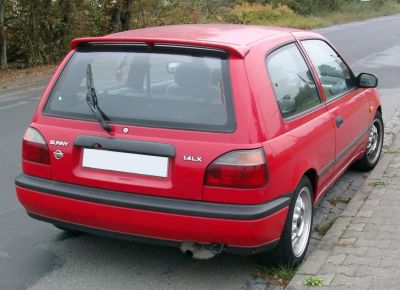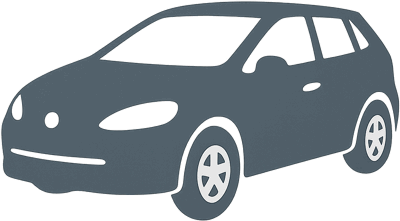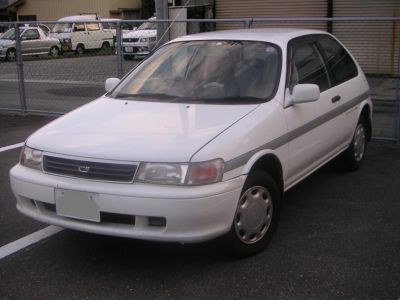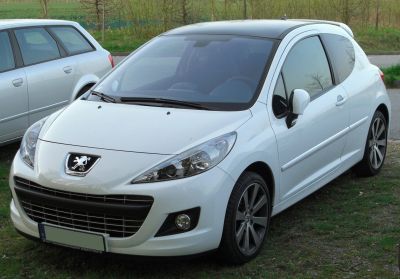 1988 Volkswagen Golf II (3-door, facelift 1987) Dimensions, Size & Specs
1988 Volkswagen Golf II (3-door, facelift 1987) Dimensions, Size & SpecsMeasurements of the 1988 Volkswagen Golf II, engineered for optimal performance and comfort
| Dimensions | |
|---|---|
| Length: | 3985-4040 mm156.9-159.1 in13.1-13.3 ft |
| Width: | 1665-1700 mm65.6-66.9 in5.5-5.6 ft |
| Height: | 1400-1415 mm55.1-55.7 in4.6-4.6 ft |
| Trunk Capacity: | 230-345 liter8.1-12.2 cu ft |
| Trunk Capacity (Max): | 1030-1145 liter36.4-40.4 cu ft |
| Weight Specifications | |
| Curb Weight: | 885-1195 kg1951-2635 lbs |
| Maximal permitted Weight: | 1370-1640 kg3020-3616 lbs |
| Tire Specifications | |
| Rims Sizes: | 13-inch rims:
|
| Tire Sizes: |
|
The Volkswagen Golf II 3-door facelift edition, produced from 1987 to 1991, stands as a quintessential compact hatchback that continued to solidify Volkswagen's reputation in the late 1980s automotive market. Introduced with refined styling updates in 1987, this facelift model combines practicality with a distinctive design that appealed to drivers seeking both style and function. The hatchback's length varies between 3985 mm to 4040 mm (approximately 157 to 159 inches), while its width spans from 1665 mm to 1700 mm (about 65.6 to 66.9 inches). Standing at a height of 1400 to 1415 mm (55.1 to 55.7 inches), the Golf II maintains a low and sporty stance ideal for urban mobility and comfortable daily driving.
Curb weight ranges from 885 kg to 1195 kg (1952 to 2634 lbs), reflecting various engine and equipment configurations. The vehicle's maximum gross weight spans from 1370 kg up to 1640 kg (3020 to 3616 lbs), ensuring robust capacity for passengers and cargo. Storage versatility is one of the Golf II's highlights, offering a luggage capacity of 230 to 345 liters (8.1 to 12.2 cubic feet) under standard conditions. With the rear seats folded down, the available cargo volume significantly expands to between 1030 and 1145 liters (36.4 to 40.4 cubic feet), catering perfectly to drivers needing extra space for larger items.
The Golf II supports multiple rim sizes, ranging from 5.5J x 13 inches to wider and larger diameters such as 15J x 6 inches, which accommodate tire sizes from compact 175/70 R13 to sportier 205/50 R15 options. These tire configurations not only optimize performance but also improve handling and ride comfort across different driving conditions.
Overall, the Volkswagen Golf II 3-door facelift remains a well-balanced hatchback offering a practical footprint with commendable interior space, sensible weight, and flexible cargo solutions. It epitomizes the late '80s era of Volkswagen design and engineering, appealing to enthusiasts and daily commuters alike who value efficiency without compromising on style or versatility.
Discover the standout features that make the 1988 Volkswagen Golf II a leader in its class
Have a question? Please check our knowledgebase first.
The Volkswagen Golf II (3-door facelift 1987) ranges in length from 3985 mm to 4040 mm (156.9 to 159 inches), varying slightly depending on the specific model and trim. The width is between 1665 mm and 1700 mm (65.6 to 66.9 inches), while the height varies from 1400 mm to 1415 mm (55.1 to 55.7 inches). These dimensions contribute to the compact hatchback form factor suitable for city driving and moderate parking spaces. The slight variations are usually due to design tweaks made during the facelift in 1987 and specific equipment like alloy wheels or bumper design.
The curb weight of the Volkswagen Golf II (3-door facelift 1987) varies from 885 kg (1,951 lbs) to 1195 kg (2,635 lbs) depending on the engine, equipment levels, and specific modifications. Lighter versions with smaller engines and fewer amenities tend to be closer to the 885 kg figure, while sportier or more equipped variants with larger engines and added features push the weight closer to 1195 kg. This range reflects the diverse lineup Volkswagen offered, ensuring a balance between performance, economy, and practicality.
The maximum weight (gross vehicle weight rating) for the Volkswagen Golf II ranges between 1370 kg and 1640 kg (3,020 to 3,615 lbs). This rating indicates the total permissible weight including the vehicle's curb weight plus passengers, cargo, and any additional load. The maximum weight influences the carrying capacity, ensuring that when fully loaded, the vehicle operates safely and efficiently without compromising braking, handling, or durability.
The Volkswagen Golf II offers a luggage capacity of 230 liters to 345 liters (8.1 to 12.2 cubic feet) with the rear seats in place, which is reasonable for a compact hatchback of its era. When the rear seats are folded down, the capacity significantly expands to between 1030 liters and 1145 liters (36.4 to 40.4 cubic feet). This versatility allows for larger loads and improves practicality for transporting bulky items, making it a useful vehicle for both daily activities and light cargo duties.
The Volkswagen Golf II (3-door facelift 1987) featured a range of tire sizes and rim options to suit different performance and styling requirements. Tire sizes ranged from 175/70 R13 to larger 205/50 R15 tires. Correspondingly, rim sizes varied from 5.5J x 13 inches, 6J x 14 inches up to 6.5J x 15 inches. These options allowed owners to tailor their vehicle’s ride comfort and handling characteristics, while also offering a choice between more economical or sportier setups.
Yes, the Volkswagen Golf II (3-door facelift 1987) fits comfortably into a standard garage. With a maximum length of approximately 4040 mm (159 inches or about 13.25 feet), width up to 1700 mm (66.9 inches or 5.58 feet), and a height of about 1415 mm (55.7 inches or 4.64 feet), this compact hatchback is smaller than most modern sedans and SUVs, making it easy to maneuver and park in typical residential garage spaces without difficulty.
Compared to its predecessor, the Golf Mk1, the Volkswagen Golf II (3-door facelift 1987) is generally larger and heavier. While the Mk1 was approximately 3700-3800 mm in length (~145.7-149.6 inches), the Golf II increased to roughly 3985-4040 mm (156.9-159 inches), offering more cabin space and improved crash safety. Width and height also saw slight increases for enhanced interior comfort and aerodynamics. Weight rose accordingly, with the Mk1 weighing around 800-1000 kg (1764-2205 lbs), whereas the Golf II ranges from 885 to 1195 kg (1951-2635 lbs). These changes reflect the evolution toward more spacious, safer, and better-equipped cars.
In comparison to other compact hatchbacks from the late 1980s, such as the Ford Escort, Opel Kadett, and Peugeot 205, the Volkswagen Golf II holds a competitive position in size and practicality. Its length (3985-4040 mm) and width (1665-1700 mm) are typical for this vehicle class, offering a robust balance of interior space and maneuverability. The hatchback design with rear seats folding flat increases cargo versatility, often exceeding rivals in luggage capacity. Moreover, the Golf II's build quality and efficient use of interior space afforded it a reputation for both reliability and everyday usability.
The 1987 facelift of the Volkswagen Golf II (3-door) included several notable design and mechanical updates. Visually, changes were made to the front grille and bumpers for a more modern and aerodynamic appearance. Headlights were updated, and some trim details were refined for better aesthetics. Mechanically, improvements were introduced in engine options with increased fuel efficiency and reliability, as well as updates to the suspension for enhanced ride comfort and handling. Interior features were also enhanced, offering better ergonomics, safety equipment, and comfort compared to earlier versions.
The Volkswagen Golf II (3-door facelift 1987) came with a variety of rim sizes including 5.5J x 13, 6J x 14, and up to 6.5J x 15 inches, equipped with matching tire sizes ranging from 175/70 R13 to 205/50 R15. Smaller rim and tire combos (13-inch or 14-inch) typically offered a more comfortable ride with increased sidewall height providing better shock absorption, ideal for urban and everyday driving scenarios. Larger 15-inch rims with lower profile tires enhanced handling and steering response, delivering sportier dynamics at the expense of ride softness. This range allowed buyers to customize their vehicles to prioritize either comfort or sportiness.
Discover similar sized cars.

| Production: | 1990-1995 |
|---|---|
| Model Year: | 1991 |
| Length: | 3975 mm156.5 in |
| Width: | 1690 mm66.5 in |
| Height: | 1395 mm54.9 in |

| Production: | 2023-present |
|---|---|
| Model Year: | 2023 |
| Length: | 4061 mm159.9 in |
| Width: | 1960 mm77.2 in |
| Height: | 1435 mm56.5 in |

| Production: | 2019-2023 |
|---|---|
| Model Year: | 2020 |
| Length: | 4060 mm159.8 in |
| Width: | 1960 mm77.2 in |
| Height: | 1435 mm56.5 in |

| Production: | 2020-present |
|---|---|
| Model Year: | 2021 |
| Length: | 4064-4070 mm160.0-160.2 in |
| Width: | 1993 mm78.5 in |
| Height: | 1450 mm57.1 in |

| Production: | 2017-2020 |
|---|---|
| Model Year: | 2017 |
| Length: | 4065 mm160.0 in |
| Width: | 1990 mm78.3 in |
| Height: | 1450 mm57.1 in |

| Production: | 1990-1994 |
|---|---|
| Model Year: | 1990 |
| Length: | 3915-3930 mm154.1-154.7 in |
| Width: | 1645-1660 mm64.8-65.4 in |
| Height: | 1370 mm53.9 in |

| Production: | 1990-1993 |
|---|---|
| Model Year: | 1990 |
| Length: | 3930 mm154.7 in |
| Width: | 1645 mm64.8 in |
| Height: | 1365 mm53.7 in |

| Production: | 2009-2012 |
|---|---|
| Model Year: | 2009 |
| Length: | 4045 mm159.3 in |
| Width: | 1972 mm77.6 in |
| Height: | 1472 mm58.0 in |
